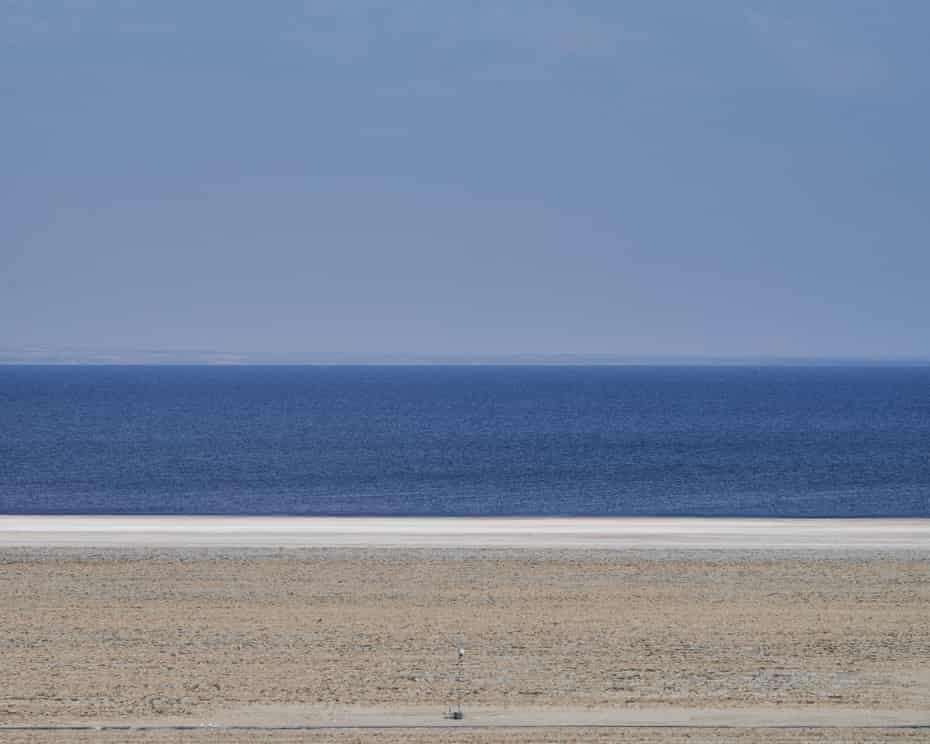Firms say what’s underneath the Salton Sea could fuel a green-energy boom. But struggling residents have heard such claims before
Standing atop a pockmarked red mesa, Rod Colwell looks out at an expanse of water that resembles a thin blue strip on the horizon. The Salton Sea, California’s largest lake, has come and gone at least five times in the last 1,300 years, most recently in 1905, when floodwaters from the Colorado River refilled its basin.
A mid-century resort destination, the lake has since become an environmental disaster zone. Its waters, long fed by pesticide-laden runoff from nearby farms, have been steadily evaporating, exposing a dusty shoreline that kicks up lung-damaging silt into the surrounding communities of the Imperial Valley, where rates of asthma are alarmingly high.
But as disastrous as the disappearing Salton Sea is, powerful people believe that a vast reserve of lithium locked beneath it and the surrounding area holds the key to flipping the region’s fortunes.
Global demand for lithium, a metal vital for the batteries in electric cars and computer electronics, is projected to grow by 40 times in the next 20 years as renewable technologies become more ubiquitous. The earth deep below the southern Salton Sea is rich in hot, mineral-abundant brine that contains some of the world’s largest deposits of lithium, and Colwell and others envision a “Lithium Valley” that would establish California as a global production hub and employ thousands of workers for generations to come.

Colwell keeps track of the Salton Sea’s water levels because as it evaporates, more land becomes available for Controlled Thermal Resources, the Australia-based lithium mining and geothermal power company where he is CEO. On this “blank canvas” of exposed land, he imagines a grid filled with huge, steam-emitting facilities, a cathode manufacturing plant for batteriesand solar panels, and rows of crops to remediate the salty white soils.
California is already pursuing a $206m lake restoration plan to try to reverse the Salton Sea’s fortunes. But people in the surrounding communities are still being sickened by the pollution – proof, says Colwell, of state failure.
“Let private enterprise deal with it,” he said of the shrinking lake. “We’re trying to commercialize an environmental disaster.”
California officials estimate about 600,000 tons of lithium could be produced every year in the Imperial Valley – an amount that would upend global supply chains, especially if related businesses like battery and cathode makers decided to relocate here.

The state has convened a “Lithium Valley” commission to study the potential industry, which envisions thousands of clean energy jobs and an economic leg up for communities along the US-Mexico border, across from Mexicali, whose residents are among the state’s poorest. But many who live here say they’ve heard similar promises before. Some fear that lithium is just the latest example of how their homes and bodies are treated as an industrial experiment, especially as the commercial-level technology needed to get at the lithium is still in its very early stages.
Fernando Leiva, a professor of Latin American and Latino studies at the University of California, Santa Cruz, has studied the effects of lithium mining in Chile, where tribes in the Atacama desert, home to the world’s largest lithium brine deposits, have seen little of the profit reaped by international mining companies who exploit the area.
It’s a concern that Leiva, who presented his research on Chile to the Lithium Valley commission this spring, sums up as “disaster capitalism”.
“The private sector now appears – they’re the ones that produced the global climate crisis that destroyed ecosystems, now they’re the ones that are going to save us,” he said.
“This could be a game changer but we have to have an open mind and not believe the spin. Understand the enthusiasm, but take it with a grain of salt.”
A ‘once in a lifetime’ green transition
The US government has a lithium supply problem. More than 80% of the world’s raw supply is mined in Australia, Chile, and China. The latter also controls more than half of the world’s lithium processing facilities and hosts three quarters of lithium-ion battery megafactories in the world; just a handful are in the US.
The Biden administration also believes securing domestic sources of lithium is vital to national security. In June, the administration released a blueprint for jumpstarting domestic lithium production and refining as well as battery manufacturing, and set a national electric vehicle sales goal of 50% by 2030.

For Colwell, whose company has been preparing to break ground for eight years, it’s a mad dash to keep up with the increasing demand driven by renewable technologies.
“When music stops, someone’s not gonna have a chair and we won’t be able to produce enough [lithium], it’s as simple as that,” Colwell says. “This is a wonderful time of transition. We’ll never see it again in our lifetime, this green transition – it’s very cool to be part of it.”
In an initial stage of the project, named Hell’s Kitchen Lithium and Power, lithium extraction plants would be powered by geothermal energy, a renewable source of power harnessed when brine is brought up from underground and flashes into steam, spinning turbines.
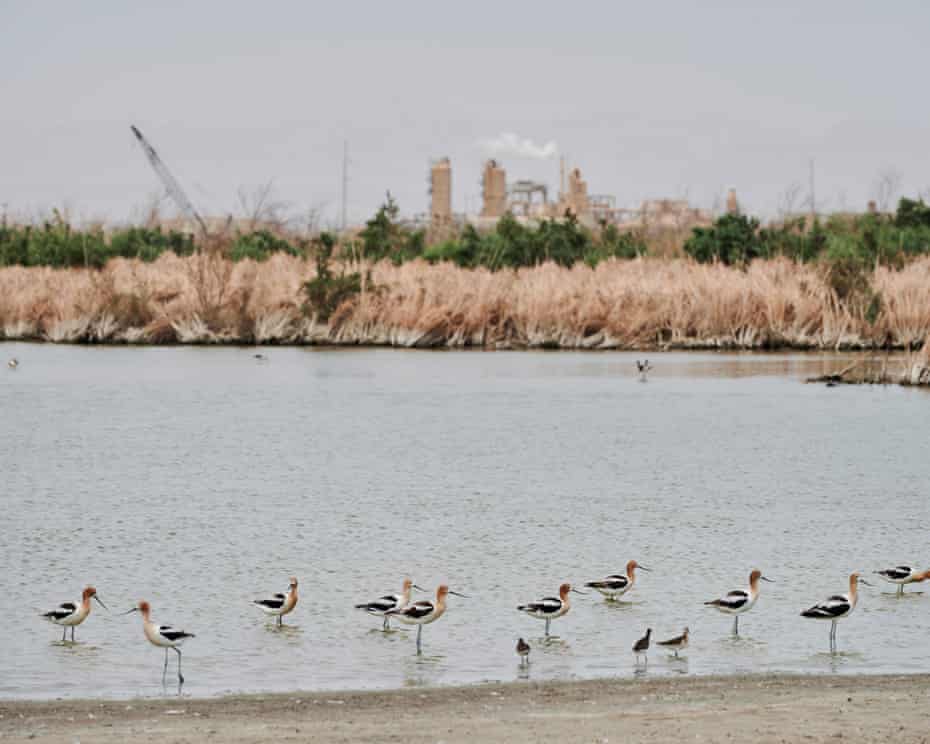
The company estimates an initial lithium and geothermal plant will cost $520m to build and will produce 40,000 tons of lithium along with 130 megawatts of power a year by 2024. Thirty per cent of the energy would be used to extract lithium, and the rest would be sold, Colwell hopes, to car companies for charging stations as well as utility companies in California and Arizona. By decade’s end, as more of the Salton Sea dries up, Controlled Thermal Resources will be able to operate on nearly 7,300 acres.
The heart of the operation will be a minerals facility where small beads are used to suck lithium from brine to produce lithium carbonate, one of two types of lithium products used in electric car batteries. The novel technology has been tested by companies around the world this year, including the in US, China, and France.
Unlike the Salton Sea region, where lithium-rich brine sits deep underground in hot metamorphic reserves, salt lakes in Chile and Argentina don’t produce heat that can be converted to geothermal energy. Minerals from those lakes have typically been extracted using evaporation ponds, a slower process.
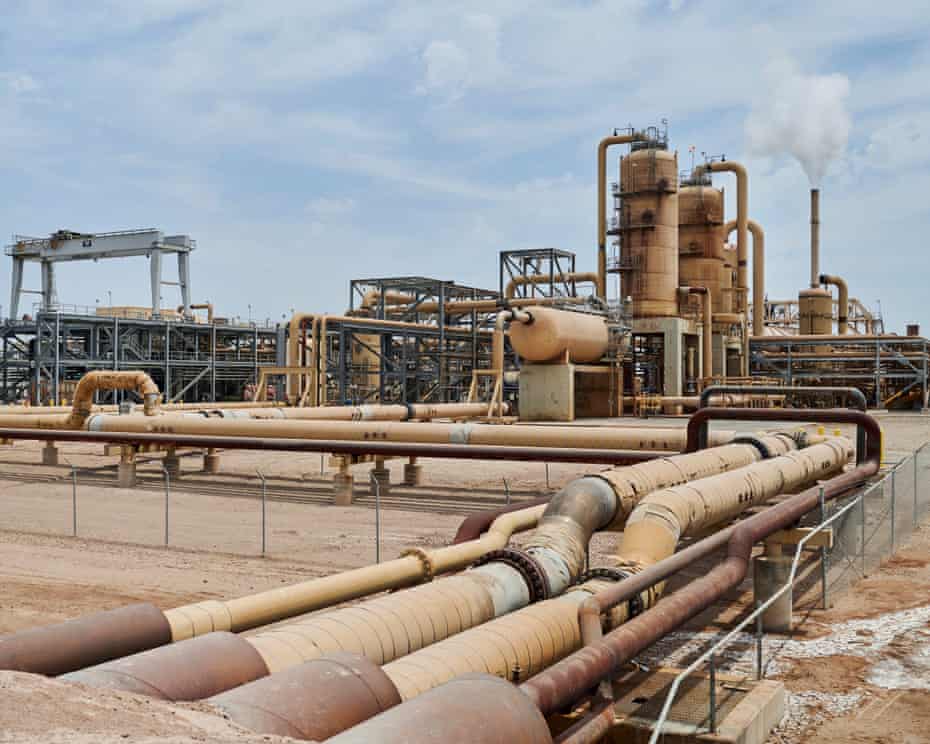
Over the last 10 years, rock mining for lithium has increased with global demand, but it won’t be enough to sustain it, according to Dave Snydacker, CEO of Lilac Solutions, the company providing the technology for Hell’s Kitchen.
“Brines contain most of the lithium in the world,” said Snydacker. “We need brine resources to come online and come online fast.”
Controlled Thermal Resources won’t reveal its investors, but in June, GM invested an undisclosed amount in exchange for first dibs on Hell’s Kitchen lithium, part of its $35bn pivot to electric cars.
Past promises, little follow-through
For all the hype, lithium in the Imperial Valley is far from an assured thing.
Speculators have sent the price of lithium and other metals soaring, encouraging investment but also threatening the affordability of electric cars. A mismatch of supply and demand for the metal could lead to an industry downturn in the near future, possibly affecting the region’s potential economic revival. That’s just one of several uncertainties, another one being whether governments can stimulate enough demand, sometimes in the face of fossil fuel opposition.
It wouldn’t be the first time that renewable enterprise and other grand ideas have failed to deliver benefits to residents in this community, a patch of desert between the Salton Sea’s southern edge and the US-Mexico border that was transformed into an agricultural breadbasket a century ago.
“The reality here is that we have seen international trade promises that have yet to be delivered, solar promises that have yet to be delivered, water promises … housing, geothermal, wind,” according to Tom Soto, a founder and managing partner at the Diverse Communities Fund who delivered the remarks to the Lithium Valley commission’s first meeting in March.
“There have been a lot of promises that were supposed to have been delivered to the most economically depressed, disadvantaged areas.”
More than a fifth of people in the Imperial Valley live below the poverty line and 85% are Latino; thousands also work here while commuting home to Mexico.
It’s also a land of vast inequality. In the town of Brawley, 20 miles away from 11 geothermal plants clustered by the Salton Sea, residents on the west side live in large houses with manicured lawns. These homes belong to ranch owners, law enforcement officers and other well-off people, according to Miguel Hernandez, the former communications coordinator for Comite Civico del Valle Inc, a community advocacy organization founded by farmworkers.
Hernandez, 31, moved to Brawley six years ago. He was born in Mexicali but, like many here, he grew up on both sides of the border. At Comite, where he worked until September before taking a job with the state, his work included building environmental literacy among residents.
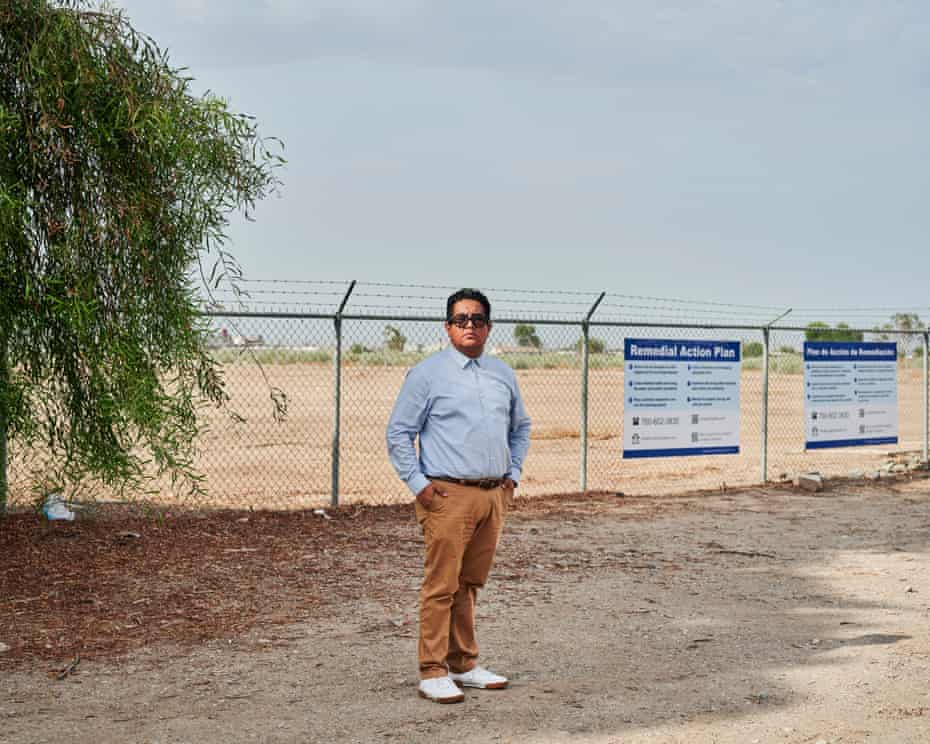
Riding in the passenger seat with the air conditioner blasting, Hernandez observes abandoned buildings on the city’s main street, where faint clouds of dust billow from a nearby trucking company. We drive to the poorer east side of town, where a block of houses sits across the street from a former fertilizer factory now owned by Chevron. The Guardian spoke with residents who lived in that neighborhood about the lithium plans. Most hadn’t heard of them.
Flerida Banueles stood underneath the pink roof of her house as temperatures reached 120F. Her three grown children had all left for San Diego because of a lack of opportunity here, she said. Banueles said she wasn’t familiar with the lithium industry but she supported the idea if it brought more jobs to the region.
“I think it will be good. There will be more work – that’s much better because Brawley is very low in many things,” said Banueles, a former agricultural worker in her 50s. “The jobs here are for six months or less, and we need more opportunities for children because they leave; they find nothing here in the valley.”
The nearby fertilizer plant is indicative of how industry needs have come at the expense of residents’ health, advocates said. In addition to toxic dust billowing from the Salton Sea, the valley’s air is choked by pesticides and diesel emissions from heavy trucks, powder from rock and mineral processing facilities, and even hay. High levels of industrial pollution from Mexicali affect people on both sides of the border.
Several of Banueles’ neighbors on the block died of rare throat cancers, and she thinks it is related to the fertilizer plant. Dusty debris was removed from the site last year, and Comite Civico del Valle is surveying residents about their health.
The California department of toxic substances control is overseeing the site’s remediation. A spokesperson acknowledged that some residents could be experiencing symptoms from toxic dust but said officials had taken measures to ensure it wasn’t picked up by the wind, including by covering it with coconut fiber covers, monitoring particulate matter, and spraying it with a binding agent.
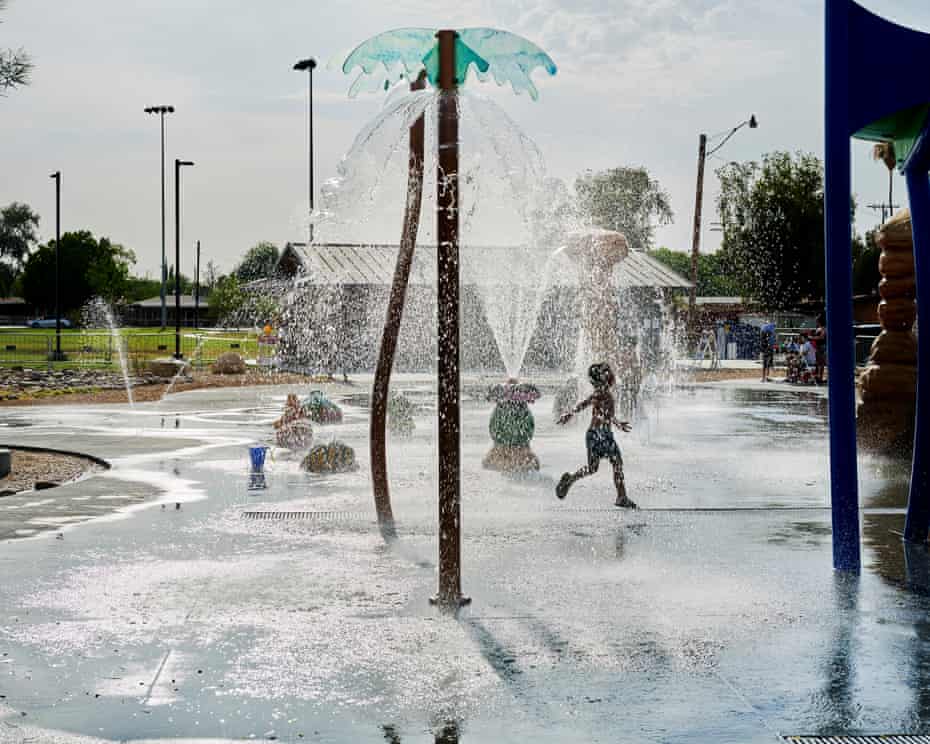
One selling point of local lithium boosters is that geothermal plants produce far less pollution and greenhouse gas emissions than fossil fuels do. The climate crisis is having a powerful impact on the region, making heat even less tolerable and depleting the Colorado River, where the Imperial Valley gets its water. (A potential risk is that the existing geothermal plants are located in an active seismic zone, where researchers in 2013 found a correlation between production and an increase in small earthquakes.)
Alan Diaz, a 33-year-old private tutor who works remotely, said that most young people who stayed couldn’t look forward to having social mobility. Public health and the environment were important, he said, but he would support practically anything that brings jobs.
“I want to see more state and federal representatives pay more attention to the Imperial Valley,” he said. “Because since we’re a Democratic county, they feel safe only tackling some issues but not really any hard questions. They should pay more attention to the people still living here.”
Funneling benefits upward
The Lithium Valley Commission, which has been tasked with presenting a state-industry blueprint to the California legislature in October 2022, is composed of lithium executives as well as social justice advocates and regional representatives, including the Torres Martinez Desert Cahuilla Indians and the Quechan Indian Tribe.
The commission is exploring the plans of several companies to expand into lithium extraction. These include Controlled Thermal Resources; Berkshire Hathaway Renewables, which already operates 10 geothermal plants near the Salton Sea; and EnergySource, another player in the region’s geothermal industry.
The commission’s meetings have exposed a tension between corporate aspirations and the surrounding communities that continue to suffer from economic hardships. Berkshire Hathaway and others have pledged to hire hundreds more workers as they expand, but Luis Olmedo, the executive director of Comite Civico del Valle, has his doubts.

Speaking at a meeting in May, he described the geothermal industry’s positive impacts as real but overhyped, and raised concerns the same could be true of lithium development.
“We are living at a time where we have been finding more and more that there have been inequities, and those inequities have resulted in disinvestment and creating extreme economic disadvantages, economic depressed areas, economic depressed neighborhoods.”
Past promises of community investment by renewable energy industries reinforce feelings of doubt. Even lithium is already tainted.
EnergySource is linked to an earlier bust, in which a startup declared it would hire hundreds at a lithium extraction facility attached to EnergySource’s geothermal plant in Calipatria. The arrangement fell through after anticipated investment from Tesla never arrived.
Similar disappointments abound: one solar project’s estimated 800 jobs are now a fraction of that after a private equity firm bought it.
Besides potential employment – which may not even benefit local residents if companies decide to hire people from outside the Imperial Valley – there’s a larger question of how to educate residents on engaging in civic life.
“When these projects come in, these benefits tend to be funneled to the more affluent in the valley because they’re the ones who are showing up in the meetings and are civically engaged and investing,” Olmedo told the Guardian.
A case in point was reported in the Desert Sun in 2017. Reporters found that a consulting firm had effectively captured the Imperial Irrigation District, the local authority that supplies water and power (and from which Controlled Thermal Resources is now leasing land). The district had approved solar projects and a battery storage project that personally benefited a small group of public officials and private executives.
One of those officials, James Hanks, is on the Lithium Valley Commission. (In an emailed statement, Hanks disparaged the Desert Sun’s reporting and said lithium extraction “may create hundreds of well paying jobs – jobs that our local, hard-working communities need”.)

For Fernando Leiva, the professor from Santa Cruz, these dynamics call to mind another ideological force alongside disaster capitalism: a “progressive neoliberalism” that is dominant in California and gaining currency worldwide, as western countries lean on private enterprise to lead an energy transition.
“It’s very hard for communities to navigate that confluence of interests,” he said.
In Brawley, across the street from the old fertilizer plant, Manuel Buenrostro stands on his sand-colored porch holding his state ID card, which shows that he just turned 90 years old. He worked decades ago on a ranch in Calipatria near the Salton Sea and recalls seeing dead fish washing up from the increasingly saline water.
Officials had communicated little with residents about how they were minimizing the sea’s pollution, he said in Spanish. He also hadn’t heard about lithium. He caught bits of information on the local news, but he wanted a chance to offer input.
“They haven’t even sent us a letter or anything about it,” Buenrostro said.
Next door, 70-year-old Frank Rodriguez prepares to take his wife to the doctor. A truck driver for a local beer distributor for 49 years – “I made people happy,” Rodriguez said – he was born and raised on the east side and has a daughter who now makes a living in San Diego.
For all the broken promises that he’s seen come and go, he’s still hopeful that lithium could bring better times.
“What I read is there’s going to be more jobs,” Rodriguez said. “But, you know, sometimes those things hold true and sometimes they don’t. I don’t know, man. It’s a good thing for the valley. And I’m kind of optimistic, but I wouldn’t know whether that’s the case or not.”
